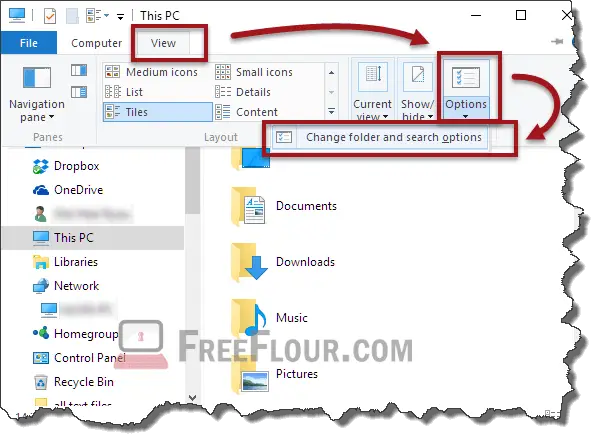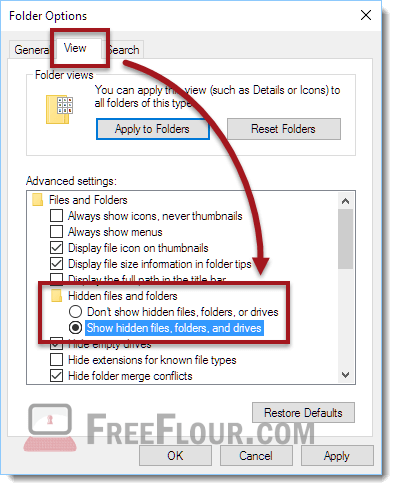In Windows 10, there are often files and folders which were set to be hidden by default such as the temp folder (temporary files), the ProgramData folder (which stores important information of nearly every software installed), fishy files or folders that you suspect were set to be hidden by your family member, malicious files that you suspect are viruses, trojans or malwares, etc. This simple tutorial will show you how you can easily set your file explorer to show hidden files and folders in Windows 10.
Files and folders which were hidden will show up as a light colored state of icon when you set to show hidden files and folders in file explorer. This guide will not teach you how to hack into locked, zipped, password added files or folders, it will only show you how you can reveal files and folders that are actually exist but invisible in your file explorer.
How to Show Hidden Files and Folders in Windows 10 Tutorial
Open File Explorer from anywhere you like. In Windows 10, you can access to the file explorer by simply opening the This PC icon or via the Windows Start button and then select File Explorer.
At the very top in the file explorer window, you should see the menu bar which consists of the following selections: File, Home, Share and View. If the menu bar is not visible, right click anywhere near the top of the window and select show menu bar. Sometimes when the file explorer window size is too small, the menu bar will not be visible. Try to maximize or expand the window.
Click on View, Options, then Change folder and search options. It should now open the Folder Options window.
In the folder options window, click on the View tab. Under Advanced settings, scroll down until you see Hidden files and folders option. Select Show hidden files, folders, and drives to make all hidden files and folders visible in File Explorer, or select Don’t show hidden files, folders, or drives if you decided to hide them and make them invisible.

You can now see all hidden files and folders ever created in your Windows 10 PC. They will appear as light colored (or slightly grayed) icons. They will also be shown in file explorer’s search result if they are found in the search query.

How to remove, delete hidden files or folders in Windows 10
File or folder in hidden state will still act as a normal file and is removable by simply hitting the delete key, or shift delete key to completely remove it without having to store it in your recycle bin.
Well, in some cases where the files or folders are infected or manipulated by malwares or whichever software is using the files at the moment you try to delete it, it will not be removable. In this case, you will have to close and completely stop all actions of the software that are currently using the files before you can proceed to removing them.
If the software cannot be stopped or you don’t even know which software is currently using it (most likely malwares), you can remove it when you boot your Windows 10 into safe mode. To boot into safe mode, click on Start, select Power, hold Shift and press Restart. Or simply pressing the F8 key repeatedly during boot up until the safe mode selection shows up. In safe mode, all software except windows services will not be able to run and you should be able to remove the said hidden file or folder.
An antivirus software is also able to force remove or move the infected unremovable hidden files or folders into its chest. Be sure to always have one remain active to protect your Windows 10 PC against malwares and viruses.
Additional settings other than showing hidden files and folders in Windows 10
In the above mentioned Folder Options window, in View tab and under Advanced settings, there are many other interesting options that you would want to switch on or off based on your preference such as showing extension of all kinds of files, showing file or folder thumbnail, etc.
The following are a list of options you will be able to turn on or off from the Advanced Settings window.
- Always show icons and not thumbnails
- Always show the menu bar
- Display and show file icon on thumbnails
- Display and show file size in folder tips
- Display full path in title bar
- Hide empty drives (not recommended)
- Hide extensions for known file types (uncheck to show extensions of all kinds of files)
- Hide folder merge conflicts
- Hide protected operating system files
- Launch folder windows in separated process
- Restore previous opened folder windows at logon
- Display and show status bar
- Display and use check boxes to select files, folders or items
- Use sharing wizard
- When typing into list view in file explorer
- automatically type into search box
- quick select the typed item in the window
- The Navigation pane
- show all folders
- show libraries
- expand to open all folders
But be aware of what you are about to turn on or off. It’s best for you to write down what you have done so that you can recall what you’ve touched and revert it back to default if you regret making any changes.
